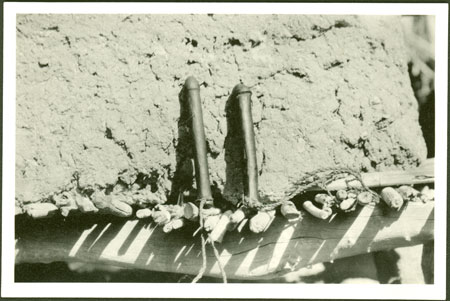Ingessana ceremonial objects

103 x 63 mm | Print gelatin silver
There are records relating to alternative images that we do not have scans for in the database:
1998.344.73.1 - Negative film nitrate , (103 x 76 mm)
1998.344.73.1 - Negative film nitrate , (103 x 76 mm)
Date of Print:
Unknown
Previous PRM Number:
EP.D.73
Previous Other Number:
M 4
Accession Number:
1998.344.73.2
Description:
Two wooden phalli (with rope ends) placed against the wall of a raised granary, used by men of the calk group.
This community group led by a hereditary female ritual expert (tau:n) are primarily concerned with the promotion of life forces in the community, hence their ribaldry and disorganisation, and specifically with children and twins.
Men suspended the wooden phalli from their waists as part of the dance, in which life-affirming activities were expressed - the word calk also meaning testicles as well as dreams.
Photographer:
Edward Evan Evans-Pritchard
Date of Photo:
1926 November - December
Region:
Blue Nile Tabi Hills ?Soda
Group:
Ingessana (Gaam)
PRM Source:
Edward Evan Evans-Pritchard
Acquired:
Donated 1966
Other Owners:
E. E. Evans-Pritchard Collection
Class:
Religion , Ritual , Ritual Object , Dance
Keyword:
Dance Accessory
Documentation:
Original catalogue lists in Manuscript Collections. Additional material in related documents files. [CM 27/9/2005]
Primary Documentation:
PRM Accession Records - Accession Book Entry [p.
98] 1966.27 [1 - 24] G[ift] PROFESSOR E.
E.
EVANS-PRITCHARD; INST.
OF SOCIAL ANTHROPOLOGY, 51 BANBURY RD.
OXFORD - 1966.27.19 - S.
SUDAN, DARFUNG.
VARIOUS TRIBES.
Box of negatives in envelopes, [1 - 242] & 1966.27.20 - Box of prints of these negatives [refers to object 1966.27.19] [1 - 242], in envelopes.
Manual Catalogues [typewritten, entitled "Ingassana"] - 73. Implements of Ceremonial dance (phalli). M.4
Note on print reverse ms pencil - "M4"
Manual Catalogues [typewritten, entitled "Ingassana"] - 73. Implements of Ceremonial dance (phalli). M.4
Note on print reverse ms pencil - "M4"
Other Information:
In A Preliminary Account of the Ingassana Tribe in Fung Province, Sudan Notes and Records X, 1927, page 74, E.
E.
Evans-Pritchard notes 'Chalk.
These are players who function at marriage, the birth of twins and the illness of children.
The head of these players possesses a wooden figure of a man or of a woman, or both, and also a wooden phallus with which he plays.
The office is generally hereditary, but anyone who learns the dances may play.' The calk institution is also discussed in detail in chapter 8 (pp.65-77) of M.C.
Jedrej's Ingessana: The Religious Institutions of a People of the Sudan-Ethiopia Borderland (E.J.Brill, The Netherlands 1995)[Chris Morton 4/2/2004]
Recorder:
Christopher Morton 4/2/2004 [Southern Sudan Project]

